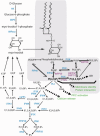Inositol, neural tube closure and the prevention of neural tube defects
- PMID: 27324558
- PMCID: PMC5353661
- DOI: 10.1002/bdra.23533
Inositol, neural tube closure and the prevention of neural tube defects
Abstract
Susceptibility to neural tube defects (NTDs), such as anencephaly and spina bifida is influenced by genetic and environmental factors including maternal nutrition. Maternal periconceptional supplementation with folic acid significantly reduces the risk of an NTD-affected pregnancy, but does not prevent all NTDs, and "folic acid non-responsive" NTDs continue to occur. Similarly, among mouse models of NTDs, some are responsive to folic acid but others are not. Among nutritional factors, inositol deficiency causes cranial NTDs in mice while supplemental inositol prevents spinal and cranial NTDs in the curly tail (Grhl3 hypomorph) mouse, rodent models of hyperglycemia or induced diabetes, and in a folate-deficiency induced NTD model. NTDs also occur in mice lacking expression of certain inositol kinases. Inositol-containing phospholipids (phosphoinositides) and soluble inositol phosphates mediate a range of functions, including intracellular signaling, interaction with cytoskeletal proteins, and regulation of membrane identity in trafficking and cell division. Myo-inositol has been trialed in humans for a range of conditions and appears safe for use in human pregnancy. In pilot studies in Italy and the United Kingdom, women took inositol together with folic acid preconceptionally, after one or more previous NTD-affected pregnancies. In nonrandomized cohorts and a randomized double-blind study in the United Kingdom, no recurrent NTDs were observed among 52 pregnancies reported to date. Larger-scale fully powered trials are needed to determine whether supplementation with inositol and folic acid would more effectively prevent NTDs than folic acid alone. Birth Defects Research 109:68-80, 2017. © 2016 The Authors Birth Defects Research Published by Wiley Periodicals, Inc.
Keywords: clinical trial; folic acid; inositol; neural tube defects; phosphoinositide; spina bifida.
© 2016 The Authors Birth Defects Research Published by Wiley Periodicals, Inc.
Figures

References
-
- Abdul‐Aziz NM, Turmaine M, Greene ND, Copp AJ. 2009. EphrinA‐EphA receptor interactions in mouse spinal neurulation: implications for neural fold fusion. Int J Dev Biol 53:559–568. - PubMed
-
- Allan SJ, Kavanagh GM, Herd RM, Savin JA. 2004. The effect of inositol supplements on the psoriasis of patients taking lithium: a randomized, placebo‐controlled trial. Br J Dermatol 150:966–969. - PubMed
-
- Araki N, Egami Y, Watanabe Y, Hatae T. 2007. Phosphoinositide metabolism during membrane ruffling and macropinosome formation in EGF‐stimulated A431 cells. Exp Cell Res 313:1496–1507. - PubMed
-
- Baker L, Piddington R, Goldman A, et al. 1990. Myo‐inositol and prostaglandins reverse the glucose inhibition of neural tube fusion in cultured mouse embryos. Diabetologia 33:593–596. - PubMed
Publication types
MeSH terms
Substances
Grants and funding
LinkOut - more resources
Full Text Sources
Other Literature Sources
Medical

